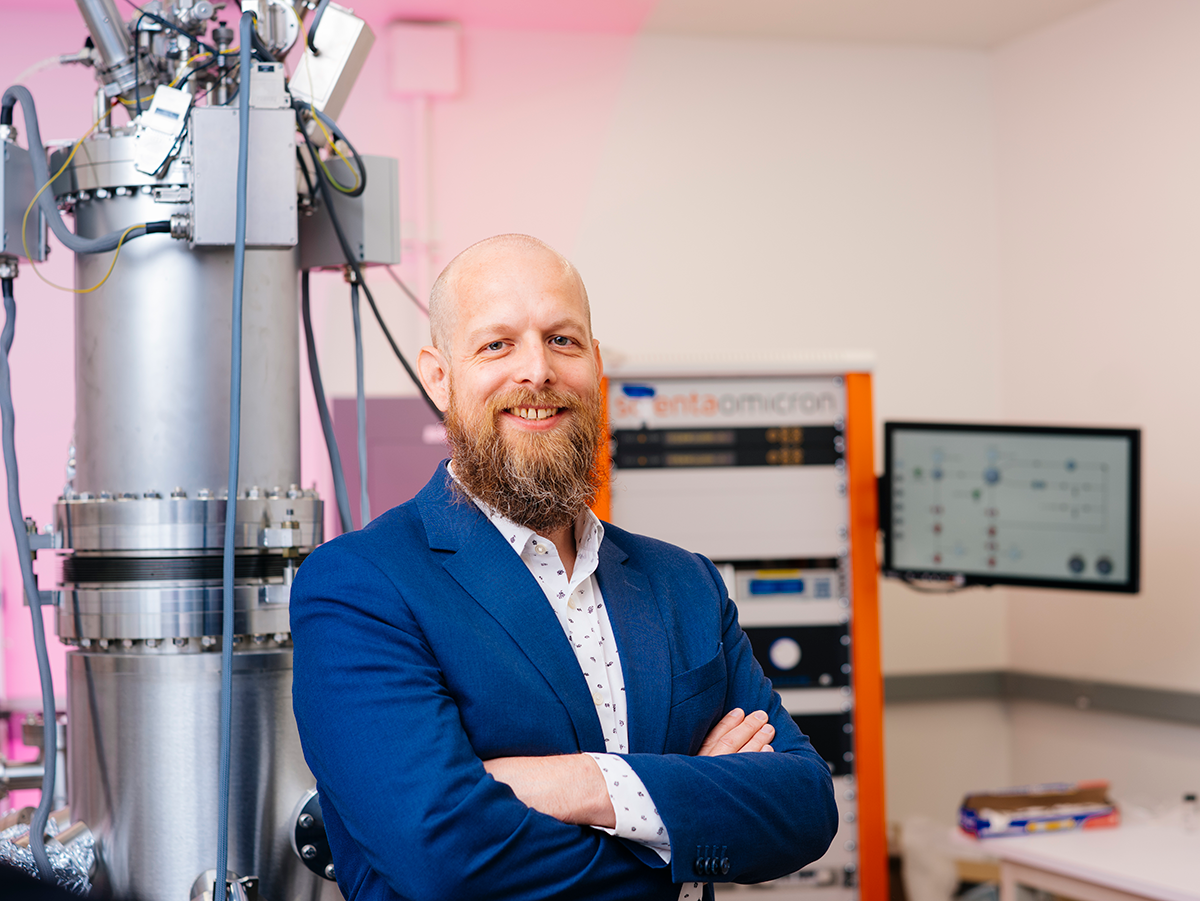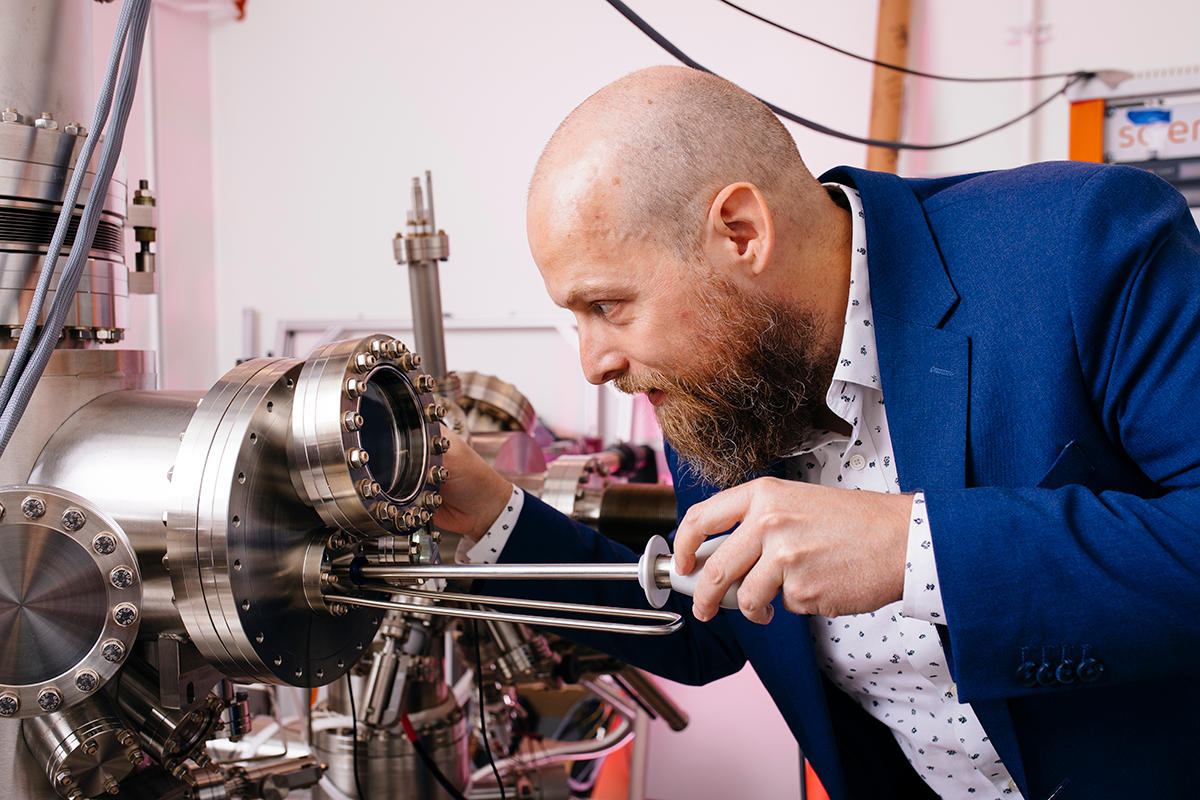Building the Materials for Next-Gen Tech

Imagine a strand of hair, how tiny and fragile it is. Now try to imagine something ten thousand times smaller, which carries electricity and data in the form of electrons zipping along its length. This is a graphene nanoribbon, a miniscule chain of carbon atoms. Because of their tiny dimensions, graphene nanoribbons have properties that larger carbon structures lack—electrons travel along them in unusual ways—and the potential to help build ultra-powerful and fast computers and sensors of the future.
Typically, researchers have created these nanoribbons by slicing and peeling small bits off larger chunks of graphene. But Felix Fischer, an associate professor of chemistry, has developed new ways of making the ribbons from scratch, using his organic chemistry expertise in molecule building. Fischer’s method gives him far more flexibility to make custom tweaks to the nanoribbons—something that’s necessary if the materials are going to be fine-tuned for applications.
“With organic chemistry, we have a lot of the tools that are needed to create structures with this very fine level of precision,” says Fischer, a 2022 Heising-Simons Faculty Fellow.
Using chemistry-based approaches to creating graphene nanoribbons, Fischer’s lab group has developed ways to integrate other kinds of atoms (like nitrogen) into the nanoribbons to give them new properties. By stitching together nanoribbons in the right configuration, they have constructed miniscule carbon wires that conduct electricity like a metal, and are already being considered for their use in semiconductors. They’ve even figured out how to trap electrons between nanoribbons, making a material that could underlie ultra-powerful quantum computers someday.
Now, armed with a 2022 Heising-Simons Faculty Fellows award, Fischer is getting closer to this goal than ever before. Among other things, he’s designed nanoribbons that—even as he works to improve and better understand—industry partners are already integrating into tiny, powerful semiconductors and sensors.
From One Field to Another
Today, most of Fischer’s research falls into the field of condensed matter physics. But Fischer hasn’t always been enamored with physics-- he’s a relative newcomer to the field, and a stack of introductory physics textbooks in his office corner illustrates his career shift. Fischer says he’s spent many late nights reading the graduate level textbooks as a Berkeley faculty member.
That’s because partway through his career, Fischer decided to apply his training as an organic chemist to some of the most challenging, complex problems in condensed matter physics.
“I wish I’d paid more attention as an undergraduate to physics,” he laughs now. “I was so focused on the chemistry part that I didn’t pick up enough of the physics, and now I’m forced to catch up.”
Organic chemists typically study and create carbon-based molecules, helping develop new methods of assembling atoms to make therapeutic drugs, fuels and other products. Many organic chemists consider their job a creative pursuit; designing new molecules is like tinkering with Legos. Condensed matter physicists, on the other hand, explore how the underlying structure of materials can help predict properties like the ability to conduct electricity, store information, or deflect light. Much of the field relies on computation and simulation to model materials in a theoretical way.
“These are two fields that traditionally couldn't be further apart from each other,” says Fischer.
But Fischer wanted a challenge, and saw an opportunity to blend the two. He knew that the materials being theorized about by physicists were poised to become the backbones of next-generation technologies in the decades to come. What if his organic chemistry techniques could help build these theoretical materials from the ground up?
“The really exciting part of this field of study is that that right from the beginning we have been flooded with very, very ambitious and creative concepts and ideas that as a chemist alone, I would've never even dared to tackle,” says Fischer.
Tinkering with Molecules
Some of the materials that condensed matter physicists study are entirely theoretical; no one has ever created them except on a computer screen. That’s where Fischer comes in; he uses organic chemistry approaches to build these materials, atom by atom.
Fischer likes to compare his work to tinkering with Legos. Theoretical physicists come up with an idea for a new material that they think should have interesting, useful properties—that’s like the beautiful picture on the front of a Lego box.
“Then you have all these little building blocks—in our case atoms and molecules—that you have to figure out how and in what order to assemble to make your structure exactly match that picture.”
The structures created for condensed matter physics applications, however, are exponentially tinier than Legos. So to even be sure his builds are correct, Fischer had to learn how to use scanning tunneling microscopy (STM), which runs a tiny metal tip along the surface of a material to determine its exact texture, down to individual atoms. Fischer compares it to Braille.

“We put the materials that we want to study on a surface, and then we move this very, very fine finger across the surface and feel the little bumps and ripples that come from the atoms,” he explains.
In 2013, Fischer was the first to apply STM to visualizing chemical reactions. Since, it’s become a mainstay of his work—his lab has three of the machines, which is unusual for a chemistry lab.
Materials with Promise
With initial results on the properties and promise of graphene nanoribbons, Fischer’s team is collaborating with TSMC—the largest semiconductor company in the world—to integrate their nanoribbons into semiconductors. And they have recently teamed up with a San Diego-based startup company that aims to use the nanoribbons in tiny medical sensors. But Fischer admits that today, we probably can’t envision what technologies will eventually be revolutionized by new materials like the nanoribbons.
“We are building this fundamental understanding of the world around us and working on very fundamental basic technologies that will enable applications decades down the road,” he says.

With his new award, Fischer will be not only continuing research on the nanoribbons, but pursuing other carbon-based materials that may have unusual magnetic properties, quantum phases, and other exciting qualities.
“This is still a pretty new field and there aren’t many groups doing what we do, so we have the luxury of having many more ideas and theories to test than we have manpower right now,” he says.
The Heising-Simons Faculty Fellows Program is accepting applications for the 2023 cycle until February 3, 2023. To learn more about the program and how to apply, please visit the program website: https://vcresearch.
